- Firearms Policy in Canada
- Firearm Facts: Realities of Firearms Ownership and Use in Canada
- The Facts: About Gun Violence and the Effectiveness of Firearm Bans
- OIC Firearm Prohibitions
- Bill C-21
Keep scrolling to see each section and download the sharable fact sheets for each one.
FIREARMS POLICY IN CANADA
OVERHAULING FIREARMS POLICY ISN’T NECESSARY: Canada’s firearms program is one of the most comprehensive and strict in the world. Training, licensing, screening, daily monitoring, as well as strict storage, transport, and use requirements, make Canada’s firearms policy extremely robust in helping to keep legal firearms out of the hands of individuals that should not have them.
FLAWED PREMISES RATIONALIZE FIREARMS POLICY CHANGES: Bill C-21, May 2020 OIC prohibitions, and Bill C-71 are based on several flawed and unsupported premises. These premises are reinforced by misleading statistics, prey on a lack of public understanding about existing firearms policy, and create unrealistic expectations and a false sense of security about the public safety enhancements that are possible with these policy changes.
BANNING LEGAL FIREARMS WILL HAVE NEGLIGIBLE EFFECT ON SUPPLY: Increasing diversion of legal Canadian firearms (through theft and straw purchasing) has been cited as the rationale for restricting law-abiding Canadian firearm owners; however, robust statistics to support this or an evidence-based connection between these issues and increased gun violence in Canada has never been demonstrated. Meanwhile, we know that gun smuggling from the U.S. continues to be the predominant contributor to illegal firearm supply and makes up most of the illegal firearms seized in Canada.
BANNING LEGAL FIREARMS WILL HAVE NEGLIGIBLE EFFECT ON PUBLIC SAFETY: In addition to having negligible impacts on the supply of illegal firearms, it relies on indirect effects (i.e., less availability of firearms for diversion to criminal use). Focusing policy and resources on actions that have indirect benefits will only achieve marginal return on investment for public safety, if any, especially when the bulk of illegal firearm supply is strongly linked to non-domestic sources (e.g., smuggling from U.S.).
BANS OF LEGAL FIREARMS WON’T REDUCE DEMAND OF ILLEGAL FIREARMS: The amount of attention that legal firearms are getting should be redirected into more effort and investment to reduce the demand for illegal firearms (e.g., organized crime). The root causes of gun violence are much more challenging to address relative to targeting law-abiding firearms owners, but are a long-term investment that is required and morally necessary to treat the problem. Otherwise, Canada will spend far more money and pay a much larger human toll if we continue to only treat the symptoms – especially if we divert focus from the real issues with redundant policy action toward
law-abiding Canadians.
MORE INVESTMENT NEEDED TO REDUCE DEMAND OF ILLEGAL FIREARMS: The government has made commitments for investments and policy towards anti-gang and other community programming, but it could be significantly enhanced using the resources that are being spent on banning, buying, and enforcing low-return actions on law-abiding firearms owners.
MORE DIRECT FOCUS NEEDED TO REDUCE ILLEGAL FIREARMS NOW: The focus should be directly on criminal activity related to firearms (e.g., smuggling, trafficking, organized crime) in short-term.
THE TAKEHOME
Many recent firearm policy proposals work to criminalize legal firearms owners, negatively impact businesses, and do nothing to address gun violence in Canada. There are many actions that can and must be taken to address gun violence and criminals before impeding on the lawful use and ownership of firearms in Canada.
FIREARM FACTS: Realities of firearms ownership and use in Canada
POPULARITY IN CANADA: There are 2.2 million licensed firearms owners, ~4,500 firearm and ammunition businesses, ~1,400 shooting ranges, and more than 1,235,000 restricted or prohibited firearms registered to individuals/businesses in Canada. Source: 2019 Commissioner of Firearms Report
VALUE IN CANADA: Firearms are an essential component of hunting, trapping, and sport shooting, and these activities result in almost $9 billion in spending and contribute $6 billion to the GDP, while supporting 47,000 jobs and almost $3 billion in labour income. Source: Conference Board of Canada
LICENSING: There are three main types of firearms licences in Canada – non-restricted, restricted, prohibited. All handguns are classified as restricted (or prohibited) firearms in Canada.
TRAINING: It requires demonstrated competency to receive a firearms licence (Possession and Acquisition Licence (PAL)) by passing written and practical tests (min. 80%) following the completion of the mandatory Canadian Firearms Safety Course. Anyone wanting to acquire restricted firearms must also take the Canadian Restricted Firearms Safety Course and pass additional written and practical tests. PALs with prohibited privileges are only available to individuals with grandfathering for a prohibited firearm. See OFAH’s What’s Involved in Acquiring a Firearms Licence in Canada for more details.
ELIGIBILITY & REFUSAL: Firearms owners are one of the most vetted segments of Canada’s population. New PAL applicants undergo a rigorous screening process (background check), and between 2014 and 2019, 4,854 applications were refused. Source: 2019 Commissioner of Firearms Report
LICENCE REVOCATIONS: Existing firearms owners undergo daily “continuous eligibility” screening to verify there has been no criminal activity since acquiring their licence. Between 2014 and 2019, 15,822 licences were revoked. Revocations (and refusals) occur for many reasons, including court-ordered prohibitions/probation, domestic violence, mental health, potential risk to self and others, and violent behaviour. In 2019, there were 474,413 individuals prohibited from possessing firearms. Source: 2019 Commissioner of Firearms Report
REGISTRATION: Restricted and prohibited firearms are ALL required to be registered with the RCMP and use of these firearms is significantly constrained through strict regulation.
STORAGE & TRANSPORTATION: There are strict rules for storing and transporting firearms, especially restricted firearms (e.g. handguns). Restricted firearms must be stored unloaded, locked, and in a locked box, or unloaded in a safe. Restricted firearms can only be transported unloaded, inoperable (e.g. with locking device), in a locked container, and requiring an Authorization to Transport (ATT) from the Chief Firearms Officer that states it can only occur for a specified purpose and in the most direct route. It is a federal offence if found in possession of restricted or prohibited firearm in an unauthorized location. Beyond police, there are very few citizens authorized to carry handguns, and it is generally related to a profession (e.g. armoured truck guards). All restricted firearms owners are required to join a government-certified shooting club to be eligible for an ATT.
THE TAKEHOME
Licensed Canadian firearms owners are highly trained, highly vetted, and highly regulated. Canadians licensed to own restricted firearms are only permitted to store, transport, and use firearms under very strict circumstances. Canada has a proven system that identifies issues and works to keep legal firearms away from individuals who should not possess them.
THE FACTS: about gun violence and the effectiveness of firearm bans
GUN VIOLENCE TRENDS: Firearm-related violent crime is a small percentage of all violent crime in Canada (3% in 2017), which is less than one half of one percent of overall police-reported crime in Canada; however, the four years (2014-2017) did see a significant increase in violent crime involving firearms. Source: Statistics Canada
MISLEADING STATS: Firearms policy changes, including bans, are justified using cherrypicked, incomplete, and misleading statistics to build a narrative. The year 2013 is repeatedly used as a statistical benchmark to ‘demonstrate’ a firearms crisis in Canada. The 42% increase in firearm-related violent crime rate from 2013 to 2017 is a very short period and uses a baseline (2013) that was the lowest for many relevant categories during the past 50 years (e.g., criminal homicides). In fact, the 2017 rate was lower than 2009, and Minister of Public Safety Ralph Goodale acknowledged that long-term trends for firearms-related crime in Canada had actually declined during his May 8, 2018 testimony to the Standing Committee on Public Safety and National Security.
GANGS DRIVING GUN VIOLENCE STATS: Since 2013, gang-related firearm homicides have almost doubled. After declining 37 percent from 2009-2014, the gang-related homicide rate rose for a third consecutive year in 2017. There were 0.44 gang-related homicides per 100,000 population, the highest rate since comparable data became available in 2005. In 2016 and 2017, about one-quarter of all homicides were gang-related, up from 16%-17% each year 2010-2015, with nine in ten committed with a firearm. Nearly 52% of homicides with a gun are now gang-related. Source: Statistics Canada
UNKNOWNS ABOUT FIREARM-RELATED VIOLENT CRIME: Statistics related to the origins of crime guns, whether gun crime is linked to organized crime, the ethnicity and socioeconomic characteristics of victims and offenders are still largely unknown. Source: Statistics Canada
MOST ILLEGAL FIREARMS AREN’T DOMESTICALLY SOURCED: Despite uncertainty, ~85% of all handguns seized in Toronto in 2020 were traced back to the United States. Source: CityNews
BANS DON’T TARGET CRIMINALS: The federal government acknowledged that “any ban on handguns or assault weapons would primarily affect legal firearms owners, while the illicit market would be indirectly affected as there would be fewer available to potentially divert”. Source: Reducing Violent Crime: A dialogue on Handguns and Assault Weapons.
POLICE DON’T SUPPORT BANS: The Canadian Association of Chiefs of Police (CACP) don’t support handgun bans. In 2019, Vancouver Police Chief and then President of the CACP said in the majority of cases involving gun violence, the handguns being used are already illegal and it makes no sense to ban something that is already prohibited. Source: CBC
THE TAKEHOME
Licensed firearm-owning Canadians agree that gun crime should be reduced, but want measures implemented that directly target criminals and illegal activity. Front-line professionals and community leaders facing gun crime in Canada agree that the money spent on bans, buybacks, and redundant policy siphons critical funding away from where it is needed most – reducing smuggling, ensuring the justice system fully prosecutes offenders, and offering community and social programming to help prevent circumstances that contribute to high rates of gun violence and gangs.
OIC FIREARM PROHIBITIONS
On May 1, 2020, the Governor in Council (GIC), through Order in Council (OIC), enacted the Regulations Amending the Regulations Prescribing Certain Firearms and Other Weapons, Components and Parts of Weapons, Accessories, Cartridge Magazines, Ammunition and Projectiles as Prohibited or Restricted or Non-Restricted (SOR/2020-96) to prohibit more than 1,500 models of firearms.
–
USING AN ORDER IN COUNCIL: Section 117.15 of the Criminal Code allows for the GIC to make regulations prescribing firearms as prohibited using an OIC; however, the magnitude of changes deserved more robust dialogue and consultation, if not full parliamentary review. In addition, the use of 117.15 (2) requires that the firearms being prohibited are not used for hunting or sporting purposes. The government stated that “the Governor in Council is not of the opinion that anything prescribed to be a prohibited device, in the Annexed Regulations, is reasonable for use in Canada for hunting or sporting purposes.”
OIC-PROHIBITED FIREARMS USED FOR HUNTING: Through a survey of firearms owners, the OFAH determined that at least 64 OIC-prohibited firearms listed in the RCMP’s Firearms Reference Table were previously non-restricted and used for hunting and sporting purposes by Canadians. More than 85% of these firearms were identified as being used for hunting prior to prohibition. Additionally, the government acknowledged that some of the firearms are used for hunting through the Indigenous two-year amnesty that was included in the regulations.
MODEL-BASED APPROACH: The approach reclassified firearms using models (principal models and variants), which fundamentally overrides the long-standing firearms classification system. The firearms captured under the OIC were based on an arbitrary and inappropriate grouping of firearms labeled ‘military-style firearms’ that garnered public support solely on perception. This is not an appropriate way to classify firearms. Classification must be evidence-based, using actual form and function of the firearm.
‘MILITARY-STYLE FIREARMS’ ALREADY ILLEGAL IN CANADA: The OIC-prohibited firearms deemed to be military-style had three criteria: 1) semi-automatic action with sustained rapid-fire capability (military design with ability to receive a quickly reloadable large capacity magazine), 2) modern design, and 3) present in large volumes in Canadian market. Sustained rapid-fire capability (e.g., automatic firearms) has been illegal since 1977, so there is no such thing as a legal semi-automatic firearm with ‘sustained rapid-fire capability’ either by design or adaptation. Large capacity magazines are also already prohibited. It is not clear how the final two criteria contribute to the need for prohibition.
BUYBACK VALUATION: The specifics of the buyback have not been released. For individual owners, there are concerns that it will not adequately compensate the full value of the firearms and accessories. A uniform pricing structure is inappropriate, and a valuation system must include both replacement and the true market value (i.e., pre-May 1, 2020), and the compensation must be the higher of the two prices.
BUYBACK FUNDING: The hundreds of millions of dollars that will be set aside to buy legally-purchased firearms from law-abiding firearms owners would be better spent on targeting illegal firearms, gangs, and the social determinants of gun violence.
MORE INFORMATION ON OIC PROHIBITIONS: Please see the OFAH’s Firearms Ban FAQ – May 2020, and the comprehensive analysis in the OFAH’s letter to Minister Blair.
THE TAKEHOME
The May 1, 2020 OIC prohibitions were politically-driven instead of policy-driven. These flawed policies were based on public perception and resulted from a clear lack of consultation and preparedness. The amended regulations work to undermine an evidence-based classification system, are causing hardship for law-abiding Canadians and businesses, and will cost taxpayers significantly without the promised public safety benefits.
BILL C-21: what it all means
On February 16, 2021, Bill C-21, An Act to amend certain Acts and to make certain consequential amendments (firearms), was introduced to the House of Commons.
–
RED FLAG LAW: Would allow anyone to apply to a judge for an order to immediately remove an individual’s firearms. Currently this can only be done by a police officer, firearms officer, or Chief Firearms Officer (CFO). Concerns — This provides more opportunity for abuse of the system through unfounded claims. Although this is the nature of our justice system, the new Emergency Prohibition Order (EPO) is a criminal sanction and has more immediate consequences. The individual who the order is sought against is not notified until after the order is issued, and they would need to go through common law to fight the order because there is no appeal process. The EPO would empower the police to enter the individual’s home without warrant and seize their firearms. The EPO would also result in notification of the CFO who could immediately suspend the individual’s firearm licence. Although it is a temporary prohibition, the EPO could trigger other sections of the Criminal Code, meaning that the individual’s licence and registrations could be cancelled and guns forfeited.
YELLOW FLAG LAW: Would allow a CFO to temporarily suspend an individual’s firearms licence and prohibit an individual from using their firearms (and acquire new ones) based on receiving information (from anyone) calling into question licence eligibility. Concerns — Having this available to anyone provides more opportunity for abuse of the system (unfounded claims), no notice to the individual, and more immediate consequences.
REPLICA FIREARMS: The intent is to close the gap in the Criminal Code regarding ‘replica’ firearms by prohibiting the importation, exportation and sale of all non-regulated airguns that visually look like modern firearms (i.e., exactly resemble make and model of existing firearm). The replica firearms designation does not currently apply to airguns shooting 366-500 fps. Concerns — The onus is on owners to determine if they have a replica firearm, but the government has not committed to providing a detailed list. Additionally, replica firearms remain available for use and transport, but have limited long-term value because they cannot be sold or bequeathed as family heirlooms.
LICENCE REVOCATION: Would require the surrender of firearms during a legal challenge of licence revocation (i.e., owners would no longer retain firearms during appeal). Currently, a decision to revoke the licence must be made before removing an individual’s firearms. Concerns — Many appeals are successful because key facts may be initially left out or misrepresented. This would cause individual hardship to those wrongfully accused, and result in considerable burden on already strained police service and justice system capacity.
NEW GRANDFATHERING APPROACH: Bill C-21 makes the buyback of OIC-prohibited firearms voluntary. Concerns — Unlike previous grandfathering, the OIC-prohibited firearms are subject to non-permissive storage – no permitted use, no import, no further acquisition, no sale, no bequeathal. This would also require owners of previously non-restricted firearms to attain a Restricted PAL, register the firearm(s), and comply with stricter storage conditions.
NEW OFFENCE FOR ALTERING A CARTRIDGE MAGAZINE: The current maximum magazine capacity for firearms sold or imported into Canada is 10 cartridges for most handguns, and five for most semi-automatic, centre-fire long guns. There is currently no specific offence for ‘unpinning’ a magazine; Bill C-21 would make it a specific offence to alter a cartridge magazine to exceed its lawful capacity. This new offence actually targets criminals purposely breaking this law.
INCREASE IN MAXIMUM PENALTIES: Would increase maximum penalties for firearm trafficking, smuggling, and related offences from 10 to 14 years. This is another positive example of a policy change that targets criminals instead of law-abiding firearms owners.
IDENTIFYING STRAW PURCHASING: Would amend the Firearms Act to authorize the disclosure of information about firearms licence holders to Canadian law enforcement agencies when there are reasonable grounds to suspect the licence is being used for straw purchasing and weapons trafficking. This would enable it, but the government needs to create a comprehensive strategy to assist in identifying irregular and/or suspicious purchasing habits while investing in the systems currently in place to better coordinate the existing tools between government, police, and agencies/retailers. This is something the OFAH has been asking for, as it is a much more direct and effective policy instrument to address straw purchasing than banning firearms from law-abiding Canadians.
MUNICIPAL BYLAWS: Bill C-21 includes provisions that would make compliance with municipal handgun storage and transport restrictions through bylaws a condition of federal firearms licence. Concerns — Some of the potential concerns include: policy redundancy because handguns are already highly regulated; creating confusion and enforcement issues resulting from a patchwork of storage and transport restrictions; small business impacts because of restrictions on retailers and ranges; community club impacts because firearm range services often help fund other club activities (e.g. conservation); loss of enforcement training facilities because ranges may not be viable without public members; implementation (e.g. available or willing businesses to store firearms) and enforcement (e.g. cost to local and provincial police, as well as CFO capacity) challenges; and individual hardship on lifelong law-abiding citizens who may be required to move or give up their firearms.
Detailed analysis on municipal firearms bylaws can be found in the OFAH Backgrounder: What the ‘municipal’ section of Bill C-21 could mean for Ontario.
MORE INFORMATION ON BILL C-21: Please see the OFAH’s Bill C-21 FAQ.
INVESTMENT IN GUN CRIME CRACKDOWN AND ANTI-GANG PROGRAMMING: When Bill C-21 was introduced, the government committed $250 million in funding over five years (starting in 2021-2022) to municipalities and Indigenous communities to support anti-gang programming and prevention programs for youth-at-risk. In March 2021, the government announced that Canada Border Services Agency (CBSA) would be leading efforts to create a joint Canada-United States cross-border task force to address gun smuggling and trafficking. These are positive investments and actions that will actually enhance public safety.
Previously, the federal government pledged $327.6 million over five years on anti-gang initiatives and gun crime crackdown, with an intention to spend $100 million annually once the first five years is up (November 2017). The federal government also announced $86 million in funding to help the RCMP and CBSA combat gun and gang violence, including $51.5 million over five years for investments in an all-weather detector dog training facility, new dog teams at key highway crossings, expanded x-ray technology at postal centers and air cargo facilities, and enhanced training on the detection of concealed goods in vehicles crossing Canada’s borders. $34.5 million over five years will be used to enhance the RCMP’s new Integrated Criminal Firearms Initiative (ICFI) to build capacity for investigations, training, inspections, technology, and intelligence. These are positive investments to enhance public safety.
THE TAKE HOME
Some elements of Bill C-21, including the creation of a new offence for altering a magazine and increases in the maximum penalties for firearms trafficking, smuggling, and related offences, as well as funding for anti-gang programming are positive, but overshadowed by the unnecessary and inappropriate policies targeting law-abiding firearms owners.
The convoluted and confusing proposals for municipal firearm bylaws, and lack of checks and balances in the proposed red flag laws, yellow flag laws, and licence revocations do not respect Canada’s licensed firearms owners.
The buyback of OIC-prohibited firearms will cost taxpayers hundreds of millions of dollars and will not provide sufficient compensation for many firearms owners. This money could have been used to support actions that directly address gun violence.
More evidence-based, direct, and value-added actions and investments are needed to tackle illegal firearms and actually enhance public safety, rather than have them as a ‘throw in’ or footnote to make political policy promises seem more palatable.
The Government of Ontario should fully examine municipal bylaw-making authority with an intent to provide more structured guidance and/or provincial oversight to ensure evidence-based decision making and consistency across the province.
Municipalities should reject the downloading of the implementation of bad federal policy. The proposals will create significant issues for municipalities without the benefit of enhanced public safety.
CLICK HERE TO DOWNLOAD THE ENTIRE COLLECTION OF FIREARMS FACT SHEET RESOURCES

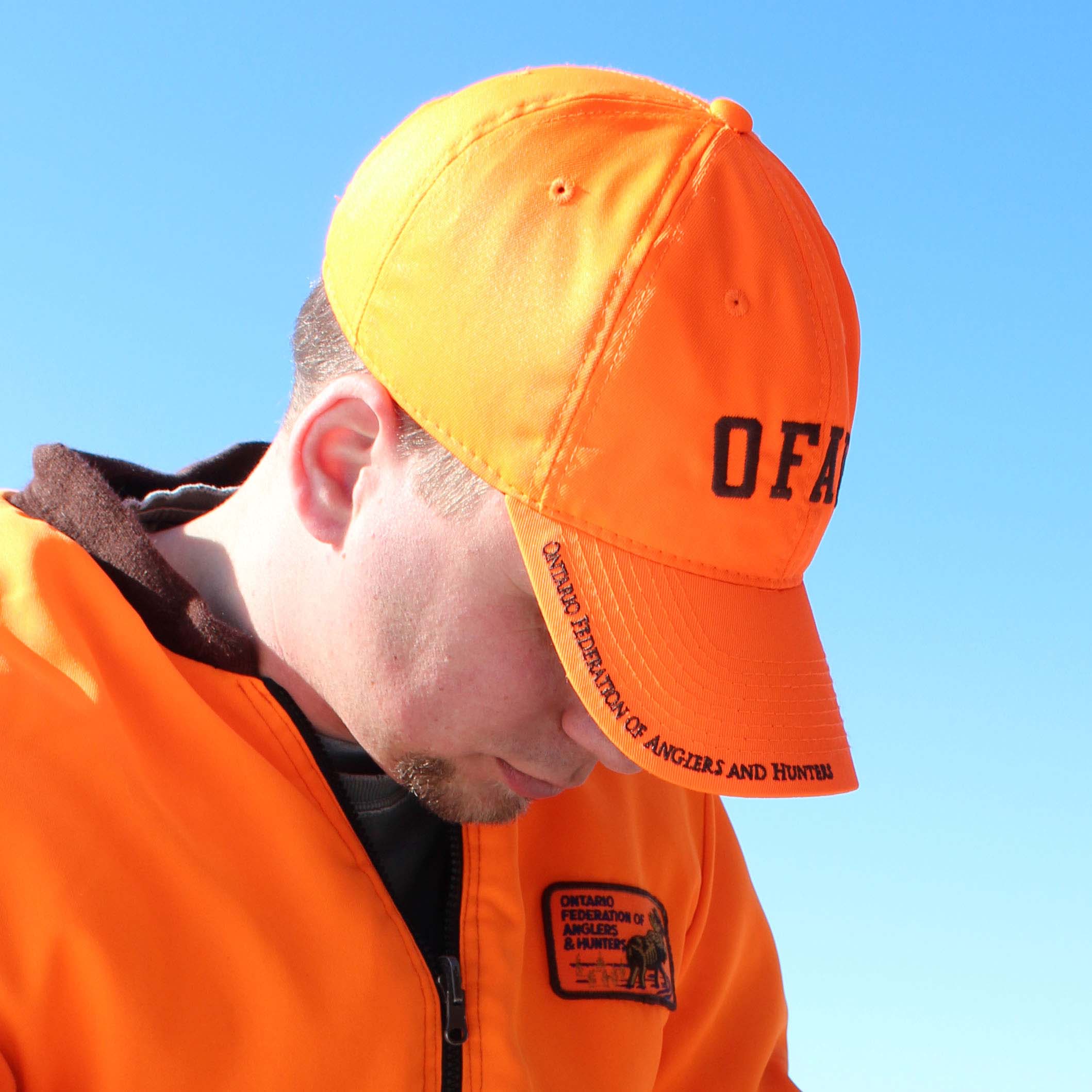
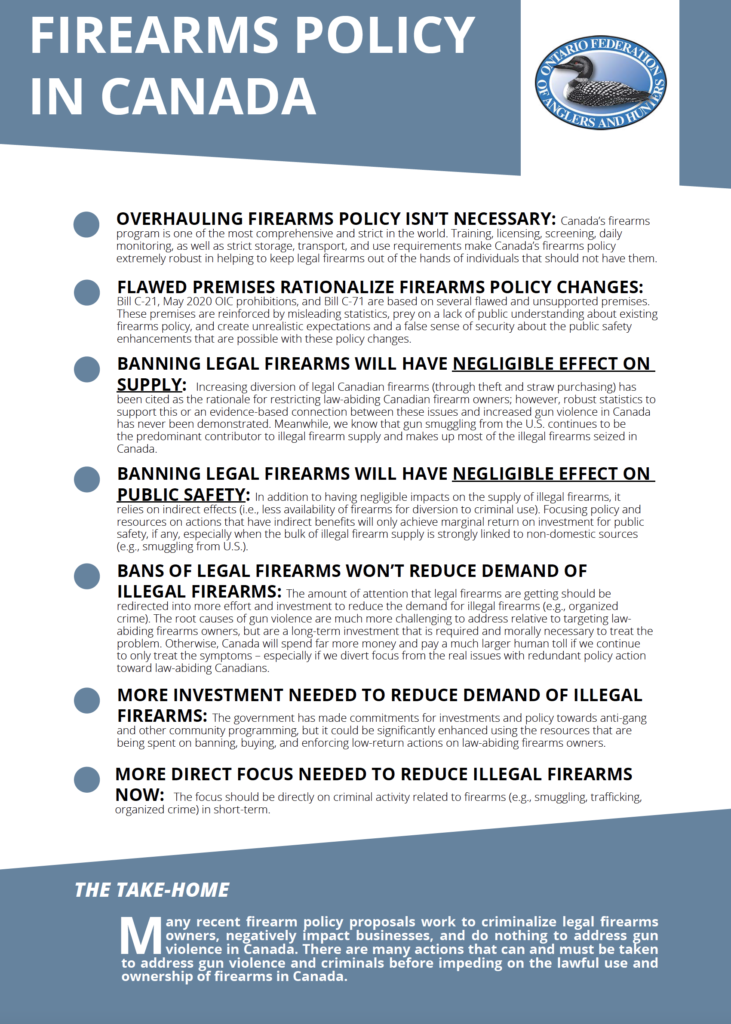
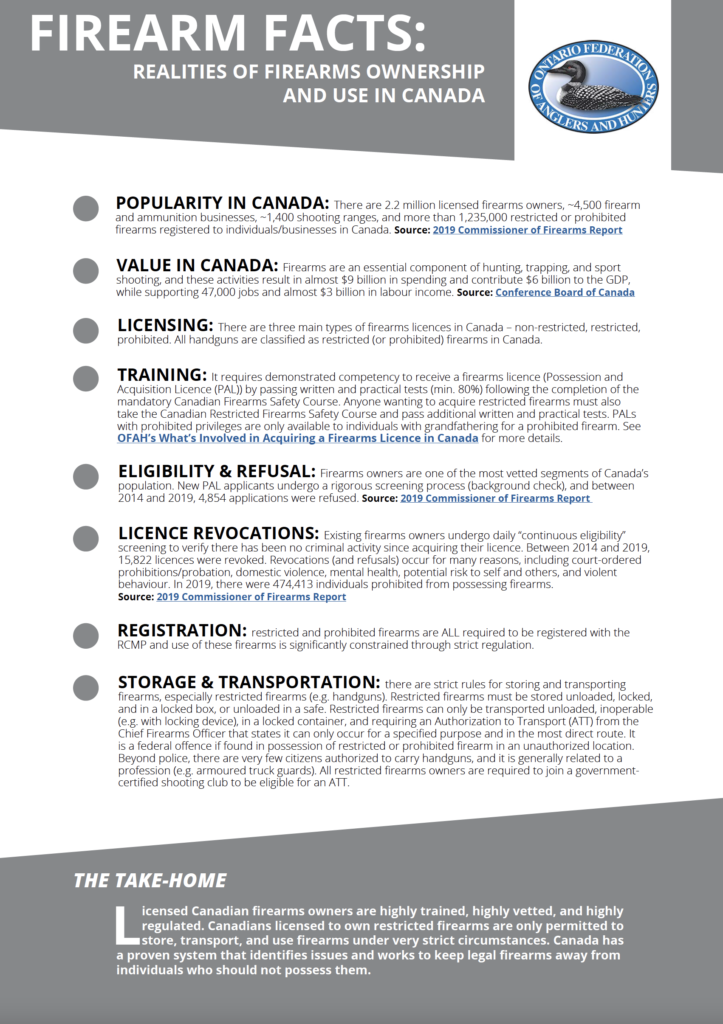
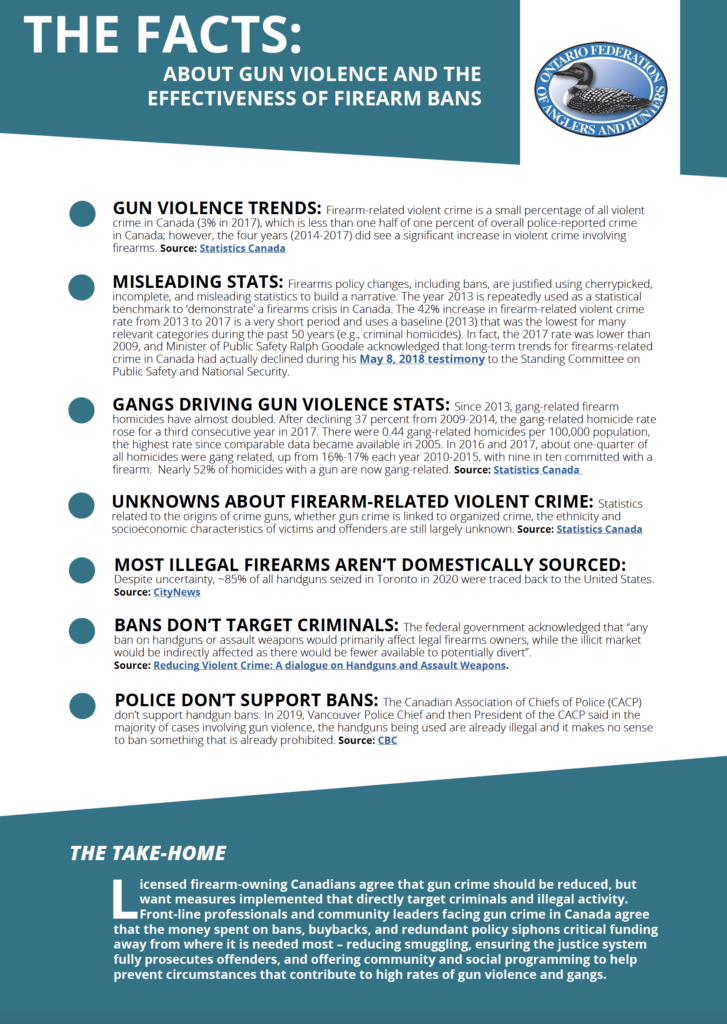
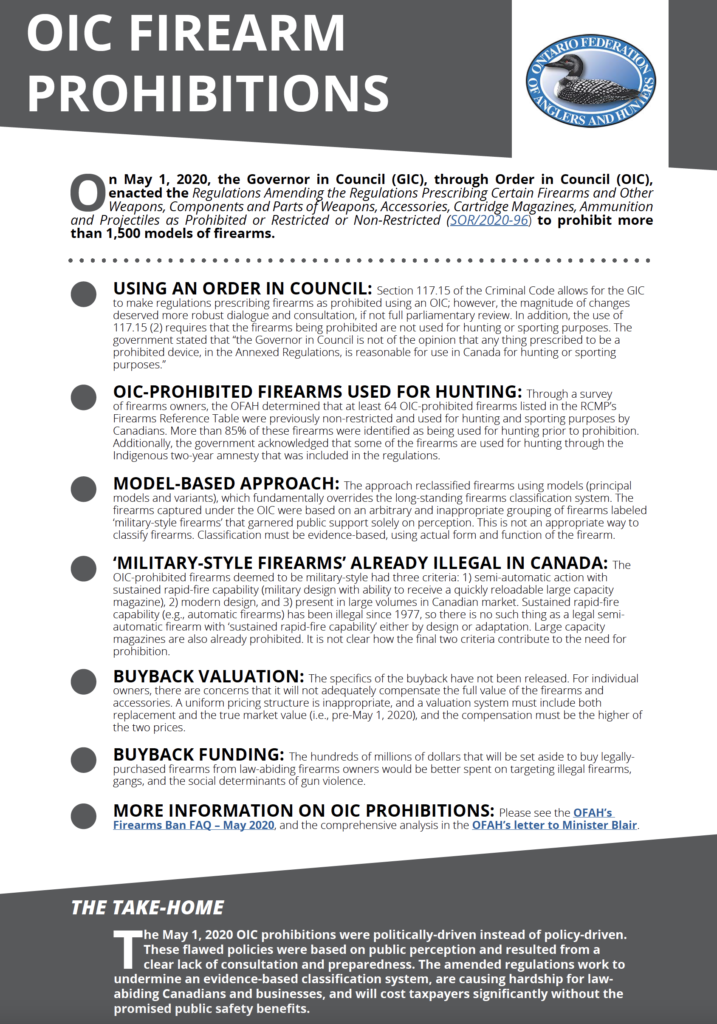
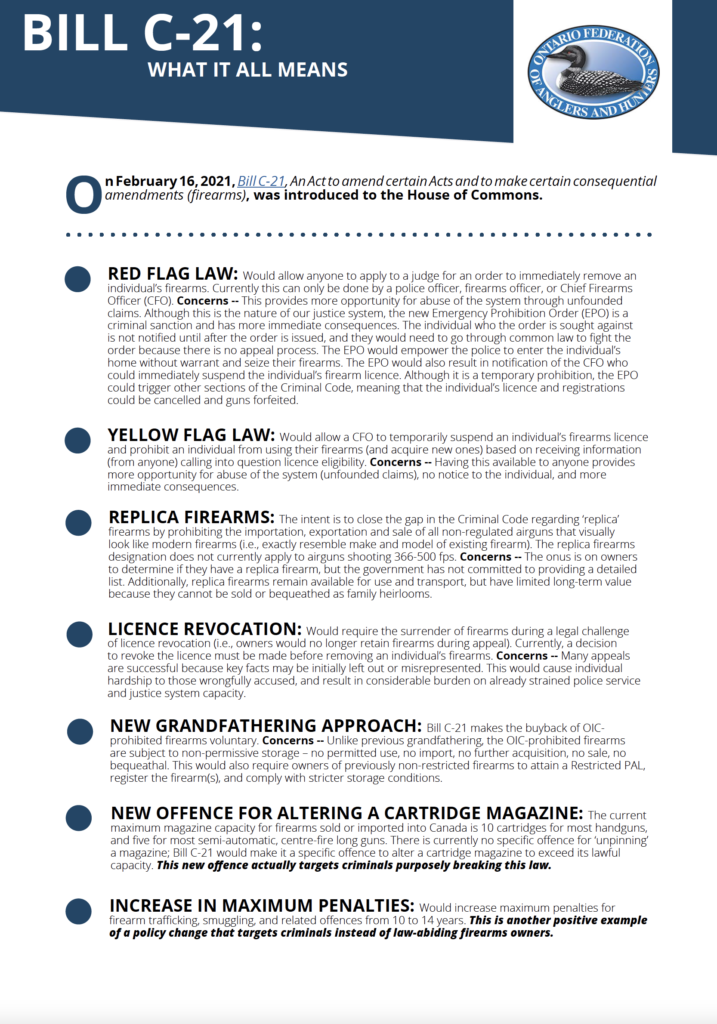

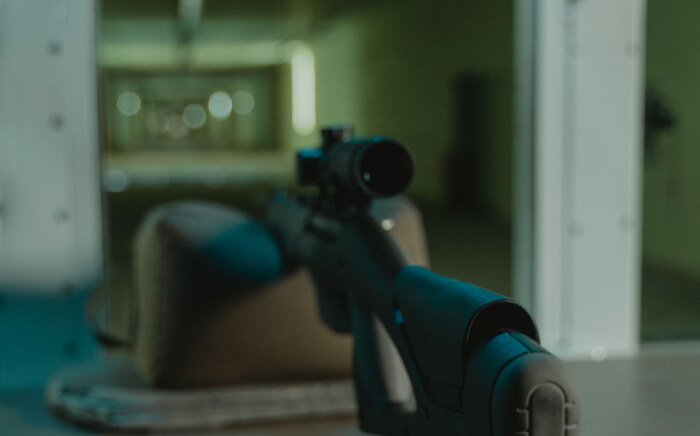
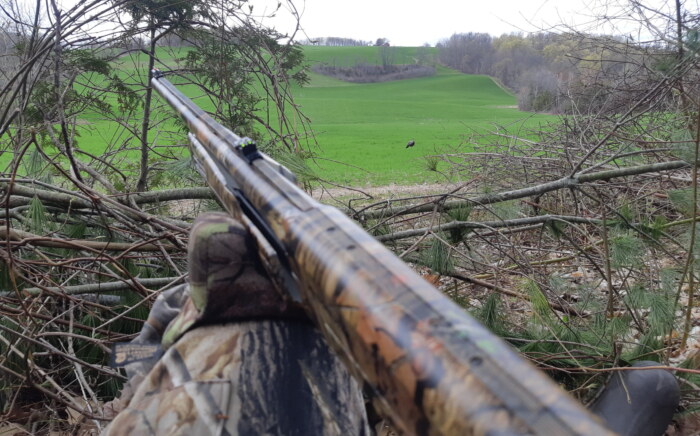

Leave a Comment